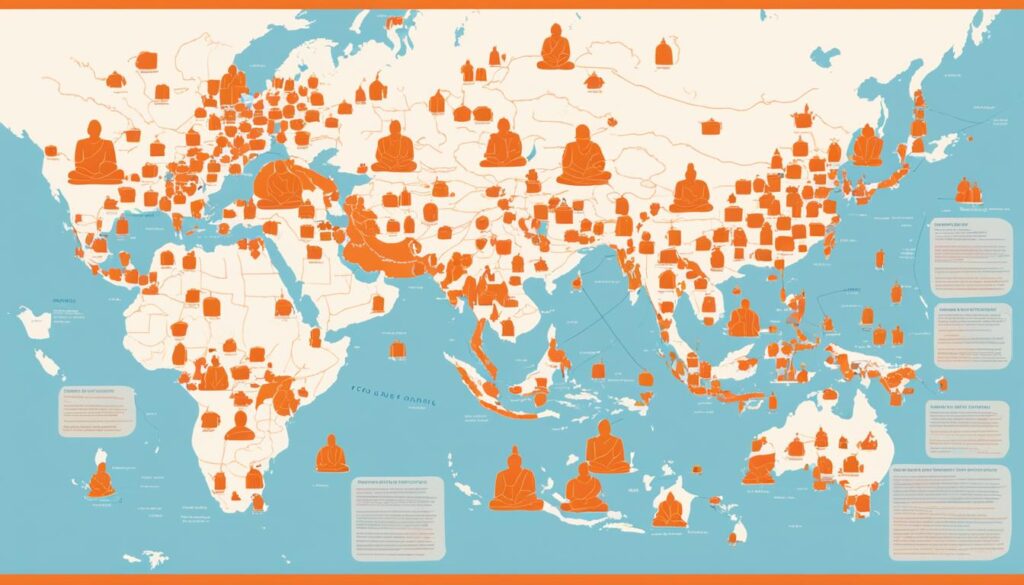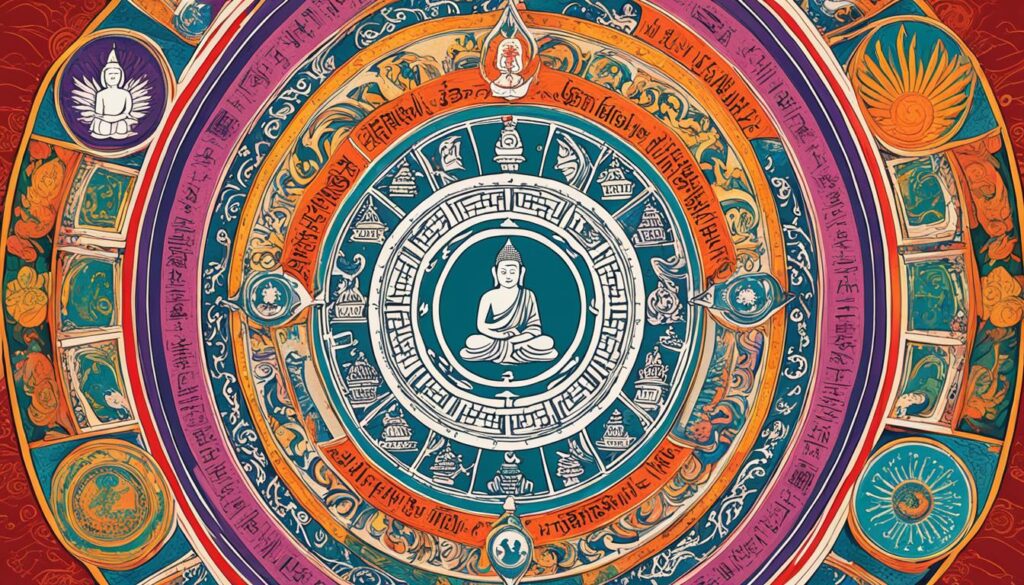Have you ever wondered how many people around the world follow the teachings of Buddhism? Are you curious about the demographics of the Buddhist community or how the religion has grown over the years? Prepare to have your questions answered as we delve into the fascinating world of Buddhism followers worldwide.
In this article, we will explore the global population of Buddhism followers, the distribution of Buddhists across different regions, the age demographics of Buddhist believers, variations in Buddhist directions, the teachings of Buddhism, and contemporary practices within the faith. By the end, you’ll gain a comprehensive understanding of the number of Buddhism followers today and the diverse nature of the Buddhist community.
Key Takeaways:
- There are approximately 488 million practicing Buddhists worldwide.
- Asia-Pacific region is home to about 99% of all Buddhists.
- China has the largest number of Buddhist followers.
- The median age of Buddhists globally is 34.
- Buddhism encompasses three main branches: Theravada, Mahayana, and Vajrayana.
Distribution of Buddhism Followers
In the global landscape of Buddhism, the vast majority of followers, approximately 95%, can be found in the Asia-Pacific region. This region is a stronghold of Buddhist faith, deeply entrenched in its rich traditions and teachings. Within the Asia-Pacific, one country stands out with the largest number of Buddhist followers – China. With a staggering 50% of the world’s Buddhist population, China’s devotion to Buddhism is unparalleled.
Aside from China, several other countries boast significant Buddhist populations. Thailand, known for its ornate temples and devout Buddhist community, is home to a substantial number of faithful followers. Japan, with its unique blend of Buddhism and Shintoism, has a longstanding relationship with the faith. Burma, Sri Lanka, Vietnam, Cambodia, South Korea, India, and Malaysia also nurture thriving communities of Buddhism enthusiasts.
Moreover, it’s fascinating to note that seven countries in the Asia-Pacific region possess a majority Buddhist population. Cambodia, Thailand, Burma, Bhutan, Sri Lanka, Laos, and Mongolia are countries where Buddhism is deeply ingrained in the fabric of society.
Buddhism Followers Worldwide – Top Countries
| Country | Percentage of Global Buddhist Population |
|---|---|
| China | 50% |
| Thailand | 8% |
| Japan | 7% |
| Burma | 6% |
| Sri Lanka | 6% |
| Vietnam | 4% |
| Cambodia | 2% |
| South Korea | 2% |
| India | 1% |
| Malaysia | 1% |

The distribution of Buddhism followers worldwide is a testament to the faith’s enduring influence and global reach. Its teachings, practices, and principles continue to resonate with millions of individuals, fostering spiritual growth, peace, and harmony throughout diverse cultures and societies.
Buddhism Followers by Age
When considering the demographics of Buddhism, it’s fascinating to examine the age distribution among its followers. Understanding the age profile of Buddhists can provide insights into the evolving nature of the religion and its ability to capture the interest of different generations.
According to recent statistics, the median age of Buddhists globally is 34, which is higher than the overall median age of the global population at 28. This data indicates that the Buddhist community tends to have a slightly older age profile than the general population.
Sub-Saharan Africa stands out as having the youngest Buddhist population, with a median age of 29. This region’s young demographic showcases the gradual spread of Buddhism beyond its traditional Asian roots, attracting followers from diverse cultural backgrounds.
In North America, Buddhists have a median age of 33. It’s intriguing to note that Buddhists in this region are younger than the general population. This trend suggests that Buddhism is attracting a growing number of younger individuals who are drawn to its teachings and practices.
Meanwhile, in the Asia-Pacific region where the majority of Buddhists reside, the median age is 34. This finding indicates that the religion has a substantial presence among older individuals in its cultural heartland.
To visually represent the age distribution among Buddhists worldwide, here is a table showcasing the median ages by region:
| Region | Median Age of Buddhists |
|---|---|
| Sub-Saharan Africa | 29 |
| North America | 33 |
| Asia-Pacific | 34 |
As this table demonstrates, Buddhists in Sub-Saharan Africa are the youngest, while those in North America are slightly younger than the global average. On the other hand, Buddhists in the Asia-Pacific region, where Buddhism has deep historical and cultural roots, tend to be slightly older on average.

By understanding the age distribution of Buddhism followers, we can gain valuable insights into the dynamics of this ancient religion in the modern world. The diversity of age profiles within the Buddhist community showcases its universal appeal and ability to resonate with individuals across different stages of life.
Variations in Buddhist Directions
Buddhism encompasses three main directions or branches: Theravada, Mahayana, and Vajrayana. Each branch has its unique characteristics and is practiced in different parts of the world.
Theravada Buddhism
Theravada Buddhism, also known as the “Way of the Elders,” follows the original teachings of Buddha closely. It is predominantly practiced in countries such as Thailand, Burma, Sri Lanka, Laos, and Cambodia. Theravada Buddhists emphasize meditation and the pursuit of enlightenment through individual effort. Monasticism plays a crucial role in this branch, with monks and nuns dedicating their lives to the practice and teaching of Buddhism.
Mahayana Buddhism
Mahayana Buddhism is considered the largest branch and is prevalent in countries like China, Japan, South Korea, and Vietnam. Sometimes referred to as the “Great Vehicle,” Mahayana Buddhism focuses on compassion and the spiritual liberation of all beings. This branch includes various schools and traditions, such as Zen Buddhism and Pure Land Buddhism, that offer different approaches and practices to cultivate enlightenment. Mahayana Buddhists believe in the Bodhisattva ideal, aspiring to help others attain enlightenment before reaching their own liberation.
Vajrayana Buddhism
Vajrayana Buddhism, also known as Tibetan Buddhism, is concentrated in Tibet, Nepal, Bhutan, and Mongolia. It is characterized by its esoteric rituals, complex visualizations, and the use of mantras and deity yoga. Vajrayana practitioners seek to attain enlightenment swiftly through a combination of meditation, deity worship, and initiation from a qualified teacher. Tibetan Buddhist monastic institutions, such as monasteries and nunneries, play a crucial role in preserving and disseminating the teachings of Vajrayana Buddhism.
Each branch of Buddhism has its unique aspects, teachings, and practices, allowing individuals to find a path that resonates with them on their spiritual journey.
Buddhist Directions Comparison
| Theravada Buddhism | Mahayana Buddhism | Vajrayana Buddhism | |
|---|---|---|---|
| Geographical Distribution | Thailand, Burma, Sri Lanka, Laos, Cambodia | China, Japan, South Korea, Vietnam | Tibet, Nepal, Bhutan, Mongolia |
| Main Emphasis | Meditation, individual effort | Compassion, spiritual liberation for all beings | Esoteric rituals, deity yoga |
| Institutions | Monasteries, nunneries | Various schools and traditions | Tibetan Buddhist monastic institutions |
| Teaching Methods | Close adherence to original teachings of Buddha | Offer different approaches and practices | Rituals, visualizations, deity worship |

The Teachings of Buddhism
Buddhism is a philosophical and spiritual tradition centered around the teachings of Buddha. It does not involve belief in an almighty God but places emphasis on finding inner peace and understanding the nature of one’s existence. Central to Buddhism are the Four Noble Truths, which revolve around the recognition of human suffering, its causes, and the path to end suffering and achieve true happiness.
The path to happiness involves acknowledging and eliminating the fundamental causes of suffering through mindfulness and meditation. By cultivating mindfulness, individuals can develop a deep awareness of their thoughts, emotions, and sensations, enabling them to observe their experiences without judgment or attachment. Through meditation, practitioners can cultivate a calm and focused mind, allowing for greater clarity and insight into the nature of reality.
The Four Noble Truths
- Dukkha: The truth of suffering – Life is characterized by various forms of suffering, including birth, aging, sickness, and death. Additionally, we experience dissatisfaction, discontentment, and the impermanence of all phenomena.
- Samudaya: The truth of the origin of suffering – Suffering arises from desire and attachment. Our cravings and attachments lead to an endless cycle of seeking satisfaction and avoiding pain, causing us to be trapped in a state of dissatisfaction.
- Nirodha: The truth of the cessation of suffering – It is possible to end suffering by letting go of desires and attachments. By cultivating detachment and non-attachment, individuals can experience a state of liberation and lasting happiness.
- Magga: The truth of the path to the cessation of suffering – The Eightfold Path provides a roadmap for achieving liberation from suffering and attaining true happiness. It consists of eight interconnected factors that guide individuals towards ethical conduct, mental discipline, and wisdom.
The teachings of Buddhism encourage individuals to strive for self-improvement and to generate compassion towards all living beings. Through the cultivation of ethical behavior, wise thought, and compassionate action, practitioners can contribute to creating harmonious relationships and a more compassionate society.
Contemporary Buddhism Practices
Buddhism is not a static religion but rather a living tradition that continues to evolve and adapt to the challenges of the modern world. One notable development within the Buddhist community is the rise of “Socially Engaged Buddhism,” a movement that seeks to address social, political, and ecological issues through Buddhist principles and practices. This movement includes both monastic and lay members and has gained widespread recognition and support among Buddhist followers around the globe.
Furthermore, various new movements have emerged to cater to the needs and aspirations of modern Buddhists. One such movement is the Dalit Buddhist Movement in India, which focuses on empowering and uplifting the marginalized Dalit community through Buddhist teachings. This movement not only offers spiritual guidance but also plays a significant role in advocating for social justice and equality.
An additional example is the Vipassana Movement, which centers around the practice of insight meditation. This movement teaches individuals to cultivate mindfulness and awareness in their daily lives, enabling them to experience personal transformation and spiritual growth. The Vipassana Movement has gained popularity in recent years, attracting both Buddhist practitioners and individuals from other spiritual backgrounds who seek inner peace and self-discovery.
Benefits of Contemporary Buddhist Practices
- Integration of Buddhism with contemporary issues: Socially Engaged Buddhism highlights the relevance of Buddhist teachings in addressing current social, political, and ecological challenges.
- Empowerment of marginalized communities: Movements like the Dalit Buddhist Movement provide support and empowerment to marginalized individuals, fostering societal equality and justice.
- Mindfulness and self-discovery: Practices such as insight meditation cultivate mindfulness and self-awareness, helping individuals find inner peace and personal transformation.
- Bridge between traditional and modern approaches: Contemporary Buddhism practices bridge the gap between ancient traditions and the needs of the modern world, making Buddhist teachings accessible to a wider audience.
These contemporary developments in Buddhism demonstrate the religion’s resilience and capacity to adapt to the changing times. Buddhism continues to attract new followers, both from its traditional strongholds and from western converts, as it offers a timeless wisdom and timeless practices that speak to the aspirations of individuals seeking spiritual growth and community.

The Four Noble Truths and the Eightfold Path
In Buddhism, the Four Noble Truths and the Eightfold Path are fundamental concepts that guide followers on their path to enlightenment. These teachings provide guidance for living a moral and meaningful life, offering insights into the nature of suffering and a path to end it.
The Four Noble Truths
- The first noble truth is the recognition of suffering (Dukkha). It acknowledges the existence and reality of suffering in life.
- The second noble truth focuses on the root causes of suffering (Samudaya). It emphasizes attachment, desire, and ignorance as the primary sources of human suffering.
- The third noble truth points to the cessation of suffering (Nirodha). It teaches that by eliminating the causes of suffering, one can achieve liberation and transcend suffering.
- The fourth noble truth offers a path to the cessation of suffering (Magga). Known as the Noble Eightfold Path, it outlines a series of practices and principles that can lead to the end of suffering and the attainment of enlightenment.
The Eightfold Path
- Right View: Develop an accurate understanding of the nature of reality and the causes of suffering.
- Right Resolve: Cultivate wholesome intentions and commit to ethical conduct, renouncing harmful thoughts and actions.
- Right Speech: Speak truthfully, kindly, and with mindfulness, avoiding harmful or divisive speech.
- Right Action: Act ethically and responsibly, refraining from harming living beings, stealing, or engaging in sexual misconduct.
- Right Livelihood: Engage in an occupation that aligns with ethical principles and does not cause harm or suffering.
- Right Effort: Cultivate positive qualities and abandon negative habits by exerting effort in one’s spiritual practice.
- Right Mindfulness: Cultivate present-moment awareness, observing body, feelings, mind, and phenomena without attachment or aversion.
- Right Meditation: Develop focused and insightful meditation practices to cultivate concentration, mindfulness, and wisdom.
The Four Noble Truths and the Eightfold Path act as guideposts for Buddhists, offering practical wisdom and principles for leading a life of compassion, mindfulness, and spiritual growth.
Conclusion
With approximately 488 million practitioners worldwide, Buddhism has amassed a significant global following. The Asia-Pacific region, including countries like China, Japan, and Thailand, is home to the majority of Buddhists. This ancient tradition has not only survived but also adapted to modern challenges, offering teachings and practices that promote personal growth and societal harmony.
At the core of Buddhism are the Four Noble Truths and the Eightfold Path, providing a roadmap for understanding suffering and achieving enlightenment. By embracing principles such as mindfulness, compassion, and social engagement, Buddhists strive to cultivate inner peace and make positive contributions to the world around them.
Whether you are seeking spiritual fulfillment, a deeper understanding of life’s complexities, or a path to personal transformation, Buddhism offers valuable insights and practices. Its global appeal and continued growth demonstrate its universal resonance, attracting a diverse range of individuals who are searching for peace, purpose, and a meaningful connection to the world.
FAQ
How many Buddhists are there worldwide?
According to recent data, there are approximately 488 million practicing Buddhists worldwide.
What is the distribution of Buddhism followers?
The majority of Buddhists, about 95%, reside in the Asia-Pacific region. China alone is home to 50% of the world’s Buddhist population.
What is the median age of Buddhists worldwide?
The median age of Buddhists globally is 34. In the Asia-Pacific region, where the majority of Buddhists reside, the median age is also 34.
What are the different branches of Buddhism?
Buddhism encompasses three main branches: Theravada, Mahayana, and Vajrayana. Each branch has further subdivisions and unique teaching methods.
What are the teachings of Buddhism?
Buddhism is centered around the teachings of Buddha and focuses on finding inner peace and understanding the nature of one’s existence. Central to Buddhism are the Four Noble Truths and the Eightfold Path, which provide guidance for living a moral and meaningful life.
How is Buddhism practiced in contemporary times?
Buddhism continues to evolve and adapt to modern challenges. One notable development is the rise of “Socially Engaged Buddhism,” which aims to find Buddhist solutions to social, political, and ecological problems. Additionally, new movements like the Dalit Buddhist Movement in India and the Vipassana Movement have emerged to cater to the needs of the modern world.
What are the Four Noble Truths and the Eightfold Path?
The Four Noble Truths explain the nature of suffering and offer a path to end it. The Eightfold Path includes elements like right view, right resolve, right speech, right action, right livelihood, right effort, right mindfulness, and right meditation. These teachings provide guidance for living a moral and meaningful life.

